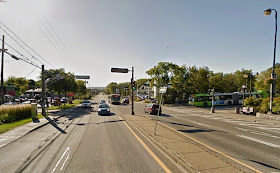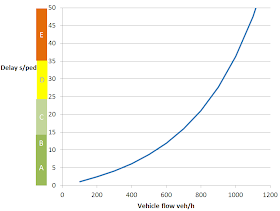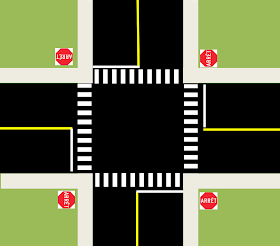I recently compared urban freeways to subways to demonstrate how they are not a cost-effective way to quickly transport great amounts of people in urban areas. However, that comparison involved very expensive and high-capacity infrastructure, that not that many cities need or can fully utilize. Many cities are also much less dense, so they may find it easier to build surface highways that can be much cheaper than the trench highway I used in an example.
So, let's see if highways make sense as a main transport infrastructure for urban developments. I will do so by comparing surface highways with urban boulevards, their cost and their capacity. But first, I must address something
Why the focus on capacity?
Some people who read this may find my choice to focus on capacity rather than, say, speed to be annoying, or even in bad faith. The choice of capacity as a metric of performance, despite capacity not being that relevant to the end user (its relevance largely limited to its effect on speed when congestion occurs), is justified by the fact that transport capacity ultimately impacts and limits development. One of the main reasons to oppose new developments by politicians is the fear of congestion, that transport infrastructures will be overwhelmed by the new developments and make current transport patterns much harder, if not impossible, to maintain. This leads to traffic impact assessments and traffic studies (which I plan to criticize in another article one day).
So lacking transport capacity caps developments, if transport links have reserve capacity, it is easier to develop areas and to increase the number of residents and jobs in an area. As such, for cities, it would be wise to seek ways to cheaply build transport infrastructure that have high capacity, to reduce the cost of infrastructure to sustain a given population.
OK, let's get started
Now, when I talk of "highway", I refer to grade-separated motorways that have no intersection, just interchanges, so as to maintain a constant speed without requiring vehicles to stop on their trips. These roads bear different names in different places in the world: motorways, expressways, freeways, highways, etc... So let me be clear, THIS is what I'm talking about:
 |
| This is an highway: wide roads without intersections, with accesses limited to ramps. |
On the other hand, when I speak of boulevard, I mean roads that are straight and built for higher capacity but which have many intersections, often controlled by traffic lights. They have sidewalks, often with buildings built on them and occasionally have bike infrastructure on them.
 |
| This is a boulevard |
 |
| So is this |
 |
| And this |
Boulevards can have different typologies, there are urban boulevards which have a relatively narrow pavement width with large sidewalks and buildings built right next to them, and there are some boulevards that are what Charles Marohn at Strongtowns calls "stroads", built with highway-like standards... but still with frequent intersections and traffic lights rather than interchanges. All are boulevards, even if the areas they serve differ. Though my comparison will mostly consider well-designed urban boulevards rather than awful stroads, the same conclusions apply.
Cost
So, the first issue is, what do they cost? There is no easy answer for highways. Highways in flatlands in rural areas can be relatively affordable, I've seen some built for about 20 millions per kilometer (30 millions per mile), sometimes a bit less. However, surface highways built in urban areas are more expensive than that, for example, the A-19 in the suburbs of Montréal is expected to cost about 600 million dollars for 9 kilometers, so a bit over 60 millions per km (around 100 million dollars per mile). This is generally due to the cost of land acquisitions and the cost of more frequent interchanges and highway bridges that need to be built.
Elevated highways are even more expensive, maybe around 200 millions per km (320 millions per mile) and underground subways are monstrously expensive, with prices frequently approaching or going over one billion per mile (see Big Dig). Again, interchanges are massively responsible for these costs, a single interchange can cost 50-60 million dollars.
As to boulevards, their costs vary much less, mainly with the number of lanes and how much money may be spent on beautification. Recently, a roughly 3-km length of boulevard was approved in Montréal, the boulevard itself is budgeted to cost 15 million dollars, so 5 million per km (8 million per mile)... and the interchange that will connect it to an highway will cost 60 million dollars.
So, overall, I will assume a cost of 50 millions per km (80 millions per mile) for an urban 4-lane (2 per direction) highway built on the surface in a low-density urbanized setting, and a cost of 5 millions per km for a 4-lane boulevard.
Capacity
The capacity of an highway lane is around 1 600 to 1 800 vehicles per hour. Some highways see as high as 2 000, but they are the exception. In general, congestion will occur at interchanges.
Meanwhile, the capacity of a lane on a boulevard is much lower, around 800 to 1000 vehicles per hour. The reason for that is simple: since they have intersections and some of these intersections will be with other highly-used boulevards, cars on the boulevard may only have the right to cross the intersection half the time. Intersections serve as bottlenecks. A boulevard without intersection would have the same capacity as an highway... and would essentially BE an highway.
Supposing a standard occupancy of 1,3 person per vehicle, that leaves a capacity in persons per per hour per direction of:
4 600 pphd for a 4-lane highway
2 600 pphd for a 4-lane boulevard
So an highway has around twice the capacity of a boulevard... HOWEVER, it also costs 10 times as much per km. The result is that more boulevards can be built for the same price. So you're not comparing one highway versus one boulevard, but an highway versus a GRID of boulevards.
 |
| 2 highways intersecting in a city, or... |
 |
| ...a grid of boulevards, each separated by 500 to 1 000 meters (1 600 to 3 200 feet) |
Vehicle capacity on boulevards is thus 5 times cheaper than on highways.
BUT WAIT, there's more...
I've been only considering capacity for cars here, but there are other modes of transport. Transit, bicycles, walking, these are ways of getting around too.
For example, if we have a bus line with 20 regular buses per hour, with each bus carrying as many as 60 people. That means a capacity of 1 200 pphd in transit. Use articulated buses instead and it's up to 2 400 pphd. Even better, have a local line and an express line on the same boulevard with different stops, and you can have two lines superposed on one another, doubling capacity. Transit will occupy some space on the boulevard and reduce somewhat vehicle capacity, but this impact is very low due to the spatial efficiency of transit.
Providing a simple 3-meter bike path (10-foot) can also get you about 1 000 pphd on bikes, widen that path a bit and you can double that to 2 000 pphd.
And sidewalks have very high capacity, with decently sized sidewalks on both sides, you could maybe get as high as 4 000 pphd on foot.
However, that's only valid for the boulevard. Cyclists and pedestrians are outright banned from highways, even if they did want to travel there (and they wouldn't). Highways create a big wasteland around them to achieve object clearance zones (or recovery zones), and their high speed favors distant, sprawled out developments that means that even if you decide to build footpaths or bike paths alongside them, no one would use them.
As to transit, though buses can certainly travel on highways, they cannot SERVE them. Vehicles are not supposed to stop on highways unless they have a malfunction. And even if they could, highways are off-limits to pedestrians. AND even if they weren't, highways rarely have walkable developments at interchanges, so the use of such buses would be limited, if not completely inexistent. So only express buses traveling long distances can really use highways.
 |
| Example from Houston, buses use parallel roads instead of the freeway to go downtown |
Still, you can use highways for express buses, shouldn't that count? Well, no. Because you can do the same with boulevards too.
So what does this mean? This means that the capacity of highways for transit is 0, for bikes is 0, for walking is 0. But boulevards, as they are space efficient and closer to developments, can easily support all these modes of travel.
So in the end, a proper comparison leads to this graph, comparing a 4-lane boulevard with a standard high-frequency bus line and bike path, a 4-lane boulevard with a high-frequency articulated bus line and bike path, a 4-lane boulevard with a tram using 2 of these lanes (thrown in just for fun) and a 4-lane highway:
 |
| Comparison of capacity between different boulevards and an highway |
Or, if some protest about including bikes and pedestrians, fine, just motorized modes:
 |
| Comparison of capacity between different boulevards and an highway, motorized modes only |
Note that I'm even low-balling transit here. You can get up to 10 000 pphd with transit on a transit-only lane if you use big vehicles and very high frequencies. And with wide enough bike paths, you can double that bike capacity.. and maybe even triple it.
So even a simple 4-lane boulevard with a bus line using regular buses can nearly match highway capacity, without including bikes in the total.
So that means that boulevards can support much more development than highways, especially urban-style development that allows trips to be made on foot or on a bike, and all for a fraction of the costs of highways.
What about speed?
OK, now let's talk of speed a little. Yes, highways allow much higher speed. A car traveling on a boulevard will travel at a speed on average between 25 and 35 km/h (16 to 22 mph), compared to an highway's speed of 100 km/h or more. Transit is even slower, at an average of 15 km/h (around 9-10 mph) for local buses, trams and BRTs can increase that to 20-25 km/h. Bikes go maybe on average at 15-20 km/h.
However, it's important to point out that since highways are so expensive and take so much space, people rarely live right next to them. Even cities with plenty of highways like Houston spaces them by 5 or 6 km between them (3,5 miles), whereas grids of boulevards can have boulevards every 500 or 1 000 meters apart. So getting on an highway may take an average of 5 minutes, likewise, getting from the exit to the destination may also take another 5 minutes. Getting to a boulevard is a much simpler affair, maybe needing only 1 minute of driving, with destinations often right on the boulevard.
As a result, the average speed of highways for urban trips isn't that much higher than on boulevards:
 |
| Average speed of trips using boulevards or highways, depending on distance, once we take into account the time to access the road |
The average commuting distance in the United States is around 8 miles, or 13 km. On such a trip, an uncongested highway saves people only 10 minutes versus an uncongested boulevard. But as I demonstrated, highways are more likely to congest due to their high cost and low capacity, so it doesn't take much congestion to make that advantage nearly vanish.
So boulevards do not support the unending sprawl that highways do as they are not as fast, but they're not that slow either. The average commute is 25 minutes in Canada and the US, supposing an average of 30 km/h for boulevards, that means 12,5 km. If you use that distance as the maximum tolerable distance from the downtown area, that represents nearly 500 square kilometers of areas close enough to downtown to tolerate urban development. With a pretty average density of 1 500 people per square kilometer, which is Riverside's overall density (not exactly the world's densest city), that means 750 000 people can live in that area. With the density of Los Angeles, so around 3 200 people per square kilometer (again, not exactly the densest city in the world), that would be enough for a city of 1,6 million people. With the density of Montréal, so 4 700 people per square kilometer, that would be enough for 2,35 million people. With European- or Asian-style density, you could house a city of 3 or 4 millions in that area.
Conclusion
I think it's pretty clear that highways are the wrong tool to deal with urban transport issues. They are too expensive and their speed is not actually required for most urban trips. They may still be justified to respond for the need for speedy long-distance trips however. Again, it justifies my point of view of not building highways in urban areas, or only a few 2-lane highways with high tolls to discourage urban trips from using them needlessly, in order to preserve their speed for long-distance trips and freight which actually need the speed.





















